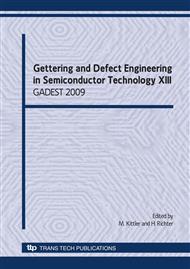p.77
p.85
p.91
p.95
p.101
p.107
p.115
p.123
p.129
Semi-Insulating Silicon for Microwave Devices
Abstract:
The concept of fully encapsulated, semi-insulating silicon (SI-Si), Czochralski-silicon-on-insulator (CZ-SOI) substrates for silicon microwave devices is presented. Experimental results show that, using gold as a compensating impurity, a Si resistivity of order 400 kΩcm can be achieved at room temperature using lightly phosphorus doped substrates. This compares favourably with the maximum of ~180kΩcm previously achieved using lightly boron doped wafers and is due to a small asymmetry of the position of the two gold energy levels introduced into the band gap. Measurements of the temperature dependence of the resistivity of the semi-insulating material show that a resistivity ~5kΩcm can be achieved at 100°C. Thus the substrates are suitable for microwave devices working at normal operating temperatures and should allow Si to be used for much higher frequency microwave applications than currently possible.
Info:
Periodical:
Pages:
101-106
Citation:
Online since:
October 2009
Keywords:
Price:
Сopyright:
© 2010 Trans Tech Publications Ltd. All Rights Reserved
Share:
Citation:


